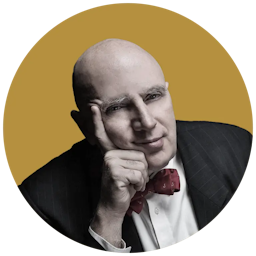If You Ask About Raymond Scott, Factor In Plenty of Time for the Answer
Three distinct ensembles have produced the first large-scale new recording in some time of classic Scott themes. Also, there’s an excellent new profile of Scott on the essential podcast series ‘The Last Archive.’

‘Raymond Scott Reimagined’
Quartet San Francisco, Gordon Goodwin’s Big Phat Band, Take Six
Violinjazz Recordings
‘The Last Archive’: Season Four
Episode 1: ‘Player Piano’
Who was Raymond Scott? The answer to that question not only depends on who’s asking, but when.
If you asked in the 1930s, the answer would be that Scott was the quirky leader of a uniquely quirky ensemble that played catchy original tunes with memorable titles. In the 1940s, it would be that Scott fronted the most high-profile big band on CBS radio — which, uniquely for its time, included Black musicians. In the 1950s, Scott was the conductor of an extremely popular TV program, “Your Hit Parade.”
To this day, when you ask me about Raymond Scott — whose real name was Harry Warnow (1908-94) — my first response is invariably that he was the author of a dozen or so original compositions that a multitude of generations grew up loving through their presence on hundreds of Looney Tunes and Merrie Melodies cartoons. I could hum “Powerhouse” or “Toy Trumpet” for you and if you’re anywhere near my age, you would likely recognize them and smile, even with my tone deaf delivery.
Produced by violinist Jeremy Cohen, “Raymond Scott Reimagined” is the first large-scale new recording in some time of classic Scott themes. As such, it involves three distinct ensembles working together: the jazz orchestra Gordon Goodwin’s Big Phat Band, the vocal group Take Six, and Mr. Cohen’s string ensemble, Quartet San Francisco.
At the same time, there’s an excellent new profile of Scott on the essential podcast series “The Last Archive.” Producer and host Ben Naddaff-Hafrey makes the point that the contribution Scott ultimately may be most remembered for is that he essentially invented musical artificial intelligence 50 years ago.
There already is an excellent documentary about Scott, “Deconstructing Dad: The Music, Machines and Mystery of Raymond Scott,” from 2010 by his son, Stan Warnow. (I’m happy to report that I’m in it, very briefly.) Mr. Naddaff-Hafrey barely mentions those aspects of Scott’s career that seemed important to us in the past — his popular quintet, the unique big band, and even the generation-transcending use of Scott’s works as a sonic signature for Bugs Bunny and Daffy Duck.
Instead, he focuses on the second half of Scott’s career, in which he abandoned both jazz and pop — indeed all of acoustic music — in order to experiment with electronics, not only pioneering the use of high-tech synthesizers and samplers but a device called the Electronium, which could actually compose music on its own, much like contemporary AI.
At the same time, “Raymond Scott Reimagined” reminds us that despite his constant tinkering later in life, no machine then or now could artificially create musical works as memorable as Scott’s own, especially those written for the quintet of the early swing era.
The new CD also makes a de facto claim for Scott that few have ever ventured: that he was a jazz composer. Indeed, though he was part of the big band era, Scott himself discouraged improvisation and rarely attempted to swing, at least in the way of Benny Goodman and Count Basie. In fact, Scott preferred deliberately non-swinging, mechanical-sounding rhythms.
“Raymond Scott Reimagined” is not necessarily a corrective, but, overall, a jazzier take on the material, something more akin to the way the Warner Bros. cartoons musical director, Carl W. Stalling, interpreted Scott’s themes, with more of a swinging 4/4 beat. The set is a kind of musical marvel, in which Mr. Goodwin’s big band provides a hard-driving backdrop for both the string quartet and the six singers. For the first time, “Powerhouse” is now a proper big band anthem, like “Sing! Sing! Sing!” or “Take The A Train.”
“In an 18th-Century Drawing Room” is an adaptation of an adaptation — Scott based it on Mozart’s “Piano Sonata No. 16 in C Major (Sonata facile)”; the new recording reimagines the Scott-Mozart defacto collaboration as a kid of jazz fugue, with Take Six singing wordlessly. The vocal sextet also vocalize on the last track, “Serenade,” and on both, Take Six sounds something like Bob McFerrin’s nonverbal choirs.
Along the way, we encounter some of Scott’s most familiar pieces, like “Twilight in Turkey,” one of his many musical travelogs. There are also lesser-heard works, like “Yesterday’s Ice Cubes.” He wasn’t as well known for his songs with lyrics, like this one, heard instrumentally, which the composer recorded with his vocalist and second wife, Dorothy Collins, though he did write the score to a Broadway musical, the 1946 “Lute Song” with Mary Martin.
The set also includes the premiere of a previously unheard Scott work, “Cutey and the Dragon,” which was finished by Mr. Goodwin. It’s just as catchy and quirky and ultimately adorable as any of Raymond’s tunes. Apart from making Scott’s music swing more than the composer perhaps intended, these excellent interpretations help bring out the inherent humanity of Scott’s best work. It’s a fitting epitaph for an innovator and ideologue who spent his entire career trying to make people sound more like machines and machines sound more like people.

